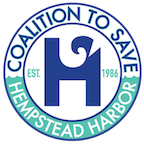Wildlife Around the Cages
The CSHH community oyster gardening volunteer sessions are starting to wrap up. The oysters from two sites (the Hempstead Harbour Club and the Sea Cliff Yacht Club) have already been planted! Over the last couple months, volunteers have seen various forms of wildlife in and around all of the cages at the four locations around Hempstead Harbor.
The most common organism that volunteers encountered this season were sea squirts/sea grapes, or Molgula manhattensis. Sea squirts are a species of tunicate, in the class Ascidiacea, native to the East Coast and Gulf Coast regions of the United States. Similar to oysters, sea squirts are filter feeders and are hermaphroditic, meaning they are capable of reproducing as both male and female throughout their lifetime, releasing sperm or eggs into the water for external fertilization, depending on environmental factors. Another form of tunicate that settles on cages and oysters are golden star tunicates, or Botryllus schlosseri. Whereas the sea squirt is a solitary tunicate, golden star tunicates grow in colonies and look like flattened flowers or stars. Despite their name, they may present in other colors, including yellow, dark purple, red, brown, or black.
Golden star tunicate, Botryllus schlosseri - the small orange-colored "stars" (9/8/24)
Sea squirts have two siphons: taking in water through one to feed, and expel water through the other. The video to the right is an example of how they got their name.
Video right: sea squirt (8/31/24)
Golden star tunicate, Botryllus schlosseri - the small black-colored "stars" (9/8/24)
Other organisms that volunteers have observed over the last two months include shrimp, blue-claw crabs, green crabs, American eels, skilletfish, marine isopods, a sculpin, and lots of mummichogs.
Sculpin (8/11/24)
Blue-claw crab (8/10/24)
Mummichogs, or Fundulus heteroclitus, a species of killifish, are estuarine fish that are able to withstand a wide range of salinity, dissolved oxygen, and water temperature, making estuaries their perfect habitat. Male mummichogs have distinct vertical stripes and can display vibrant colors (olive green on the back and steel blue on the sides) during mating season. Female mummichogs are usually paler and without stripes.
Pictured left: Mummichog (8/31/24)
One newcomer that volunteers frequently noticed in the cages this year was the mud blister worm, or Polydora websteri, a type of marine polychaete (segmented worm) that burrows within the shells of mollusks, such as oysters, but they do not eat the shellfish. They feed on materials deposited on the shell surface or particles in the water column, such as algae, using tiny tentacles called palps on both ends of the worm. As they burrow into the shells of mollusks, creating a U-shaped tunnel in the shell, they secrete mud, fecal matter, and detritus (dead matter) into the tunnel; giving them their name.
Pictured right: mud blister worm (8/17/24)







